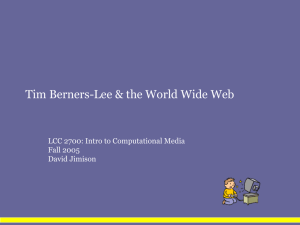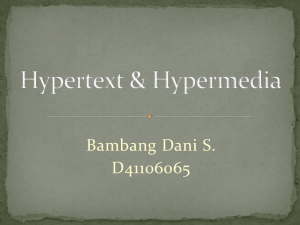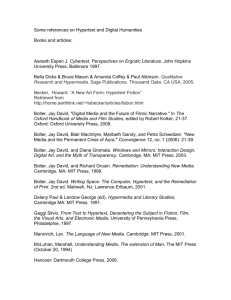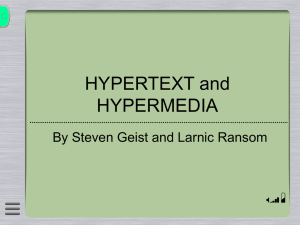Thinking styles and accessing information on the world wide web
advertisement
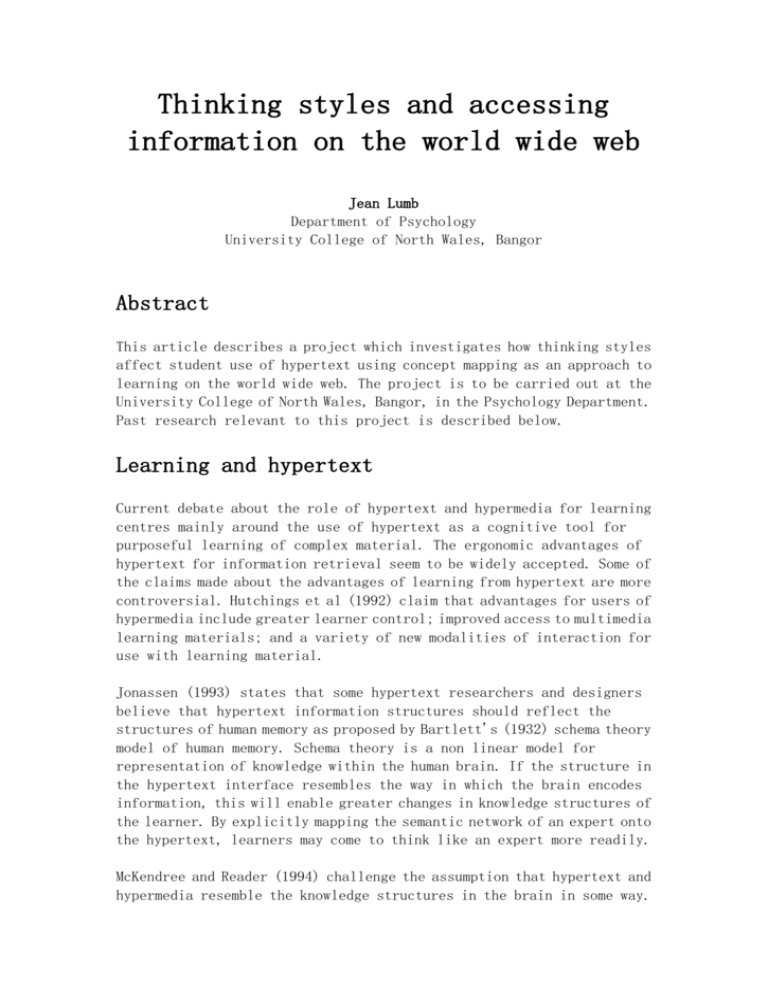
Thinking styles and accessing information on the world wide web Jean Lumb Department of Psychology University College of North Wales, Bangor Abstract This article describes a project which investigates how thinking styles affect student use of hypertext using concept mapping as an approach to learning on the world wide web. The project is to be carried out at the University College of North Wales, Bangor, in the Psychology Department. Past research relevant to this project is described below. Learning and hypertext Current debate about the role of hypertext and hypermedia for learning centres mainly around the use of hypertext as a cognitive tool for purposeful learning of complex material. The ergonomic advantages of hypertext for information retrieval seem to be widely accepted. Some of the claims made about the advantages of learning from hypertext are more controversial. Hutchings et al (1992) claim that advantages for users of hypermedia include greater learner control; improved access to multimedia learning materials; and a variety of new modalities of interaction for use with learning material. Jonassen (1993) states that some hypertext researchers and designers believe that hypertext information structures should reflect the structures of human memory as proposed by Bartlett's (1932) schema theory model of human memory. Schema theory is a non linear model for representation of knowledge within the human brain. If the structure in the hypertext interface resembles the way in which the brain encodes information, this will enable greater changes in knowledge structures of the learner. By explicitly mapping the semantic network of an expert onto the hypertext, learners may come to think like an expert more readily. McKendree and Reader (1994) challenge the assumption that hypertext and hypermedia resemble the knowledge structures in the brain in some way. They maintain that knowledge of how the brain encodes information is poorly understood. Simply having access to information or knowledge does not presuppose that learning takes place. What is needed is knowledge of the complex ways in which people learn. Learners need to actively process information in a meaningful way, to reflect upon and use the information in order for it to be truly learned. What is needed is knowledge of how people learn complex material. Jonassen (1993) accepts that merely illustrating content structures in the interface is not sufficient for helping learners acquire those structures. He maintains that it is the nature of the processing task and goals for learning while interacting with a hypertext that determines the effects of its use on learners' knowledge. Barker (1993) states that if hypermedia material is to be educationally effective, considerable thought should be given to firstly the learning goals and activities that it must support; how the nature of the underlying knowledge corpus relates to these requirements; and how learners differ from each other. Eklund (1995) is positive about the potential of hypermedia systems for incorporating these principles into hypertext software. He recommends the incorporation of advanced navigational devices such as concept maps into the software to inform users of their place in the process of knowledge acquisition and past and possible new trails to follow. A semantic (or concept) map is a graphical representation of an individual's knowledge of a particular subject area or subject domain. He also recommends the use of an adaptive interface based on several stereotypical user classes to modify the environment to suit the individual user with the user making informed decisions about where next to proceed based on his/her interpretation of the meaning of materials and at each learner 韘 own pace. Peter Whalley (1993) questions the validity of the assumption made sometimes about linear text - that, unlike hypertext, it is unstructured. He also questions whether it is desirable to deliberately fragment educational materials in order to make them more accessible. Whalley states that Grimes (1975) and DeBeaugrade (1980) have shown how under a superficially linear form, authors may create complex relational structures. Whalley states that linear texts contain turn taking cues which promote reflective critical reading. Fragmentation in hypertext makes it more difficult to perceive the author's intended argument structure. This makes it more difficult to organise hypertext materials to support higher level learning. Kommers (1990) describes the failure of hypertext as a medium to improve learning especially for less able pupils as they cannot see the wood for the trees. Jonassen (1993) carried out three studies of the use of concept mapping embedded in hypertext for learning. One of these studies resulted in improvement in student learning. The results of these are discussed below. Jonassen (1990) accepts the premise that learning is the reorganisation of knowledge structures and has used two tools for depicting those representations, utilising these tools for learning. The first is Preece 韘 (1976) method of free association of word lists to create a semantic map of knowledge and Buzan 韘 (1974) technique of notetaking in the form of pattern mapping of knowledge structures. These techniques have been incorporated into computer environments such as Learning Tool (Kozma, 1987), Semnet (Fisher et al, 1988) and Pathfinder Nets (McDonald, Paap & McDonald, 1990) for production of semantic nets. In a set of three studies, Jonassen (1990) wanted to investigate the extent to which a semantically structured hypertext affects the acquisition of structural knowledge, knowledge structures being the organisation of an individual's ideas. In the first two studies, individuals took part in a learning task where material was presented either with or without the expert 韘 semantic map of the material. In these studies, there was no difference in knowledge acquisition and structural knowledge gained between subjects presented with semantic maps compared with subjects who were not presented with these maps. However, in the third study, experimental subjects were required to create their own semantic maps of the subject field. There were still no differences in recall scores. However, in this study, subjects performed significantly better on the relationship task than the two groups instructed only to study the materials. These results support findings of Bower et al (1969) that imposing your own organisation on material as well as active involvement in processing the material meaningfully enhances learning. Craik and Lockhart 韘 (1972) studies on levels of processing also support these results. The more deeply a learner processes information, the more likely it is that the person will remember material to be learned. Thinking styles One possible way in which to determine the complex ways in which people learn is to study the way in which they think. Robert Sternberg (1995) proposes that thinking involves the representation and processing of information in the mind. One way to view thought is to consider critical thinking, in which individuals consciously direct mental processes to find a thoughtful solution to a problem as opposed to noncritical thinking, in which individuals routinely follow customary thought patterns, without consciously directing how they think. These two different types of thinking will be appropriate for different tasks. Sternberg in 1988, proposed the theory of mental self government. In a further article discussing this theory, he examines the nature of thinking styles and impact of current forms of educational assessment on individual students with differing thinking style profiles (Sternberg, 1992). Mental self government relates to the task of managing or governing everyday activities. The flexible use of the mind for mental self government accounts for a variety of thinking styles. Sternberg (1992) defines a thinking style as a preferred way of thinking. It is not an ability, but a preferred way of expressing or using one or more abilities. Two or more people at the same level of ability may nevertheless have very different styles. Sternberg maintains that styles, like abilities are in large part of a function of the environment and they can be developed. They are also fluid in the sense that different styles may be used in different situations as styles seem to be partly a function of tasks and situations. Preferred styles may also change over the lifespan. However, the fact that some people retain less rewarded styles despite environmental pressure suggests that socialisation does not account fully for the origins of styles, and that there may be pre-programmed dispositions that are difficult to change. Sternberg & Lubart (1991a) proposes that there is a link between intellectual (or thinking style) and creativity. Truly striking levels of creativity are associated with global and legislative thinking styles compared with local executive thinking styles. Individuals with a global legislative thinking style prefer relatively large abstract issues, ignoring details. They prefer the task of creating, formulating , imagining and planning. Individuals with local styles prefer concrete problems requiring detailed work and tend to be pragmatically oriented. They prefer implementing and applying ideas or plans of others. Sternberg (1992) maintains that there are consistent biases in measurements of ability which benefit some thinking styles at the expense of others. He uses the multiple choice/short answer format as an example of a type of conventional test commonly used which favours test takers with an executive, local style and somewhat those with internal conservative styles as well. He also suggests that the type of student who gets good grades as assessed by conventional tests 靉 re unlikely to be the students who are most creative when it comes to generating new ideas in their research regardless of discipline (see Sternberg & Lubart, 1991a; 1991b, p. 179.) Creative students are more likely to show profiles of styles that are legislative and global. More recent tests emphasise critical thinking and analysis, indicating there may be a shift away from benefiting executive styles. The aim of this project is to test whether there is an interaction between thinking styles and learning utilising concept mapping as a learning tool for managing material presented in either hypertext format or linear format. It is predicted that one type of learning style will be more effective with one type of presentation of material. It is predicted that there will be a significant interaction between preferred thinking styles and presentation of material in either linear or hypertext formats. Subjects with an executive, local profile will master factual knowledge more effectively through a linear approach but not see links between areas of knowledge as clearly as subjects who have a legislative, global style profile. Subjects with this second type of profile will perform well on understanding links between knowledge but will have lower scores on factual knowledge. It could be the case that the major role of hypertext and concept mapping is firstly in the management of learning. Whalley (1993) expresses concern of writers distance learning materials about the `over organised text which promotes passive learning which could be a problem for educationalists designing learning packages using hypertext. Eklund (1995) has outlined the usefulness of concept mapping embedded in hypertext for the management of learning, assisting the user in establishing current knowledge states and planning where to go next. The use of concept mapping may also have a major role to play in developing creativity, particularly the truly distinctive creativity described by Sternberg. References Barker, P. (1993) Exploring hypermedia . London: Kogan Page. Bartlett, F.C. (1932) Remembering. Cambridge: Cambridge University Press. Bower, G.H., Clark, M.C., Lesgold, A.M. & Winzenz, D. (1969) Hierarchical retrieval schemes in recall of categorized word lists. Journal of Verbal Learning and Verbal Behavior , 8, 323-343. Buzan, T. (1974) Use both sides of your brain . NY: Dutton. Craik, F.I.M. & Lockhart, R.S. (1972) Levels of processing: a framework for memory research. Journal of Verbal Learning and Berbal Behavior, 11, 671-684. DeBeaugrade, R.A. (1980) Text, discourse and process . Norwood, NJ: Ablex. Eklund, J (1995) Cognitive models for structuring hypermedia and implications for learning from the world wide web. Paper presented at AusWeb 95 Conference. Sydney, Australia : URL: http://www.scu.edu.au:80/ausweb95/papers/hypertext/eklund/index.html Fisher, K.M., Faletti, J., Thronton, R. P., Patterson, H., Lipson, J. & Spring, C. (1988) Computer based knowledge representation as a tool for students and teachers. Paper presented at the annual meeting of the American Educational Research Association, New Orleans , LA, April. Grimes, J.E. (1975) The thread of discourse . The Hague: Mouton. Hutchings, G.A., Hall, W. , Hammond, N.V., Kibby, M.R., McKnight,C. & Riley, D. (1992) Authoring and evaluation of hypermedia for education. Computers and Education , 18, 171-7. Jonassen, D. (1990) Semantic network elicitation: tools for structuring hypertext. In C. Green and R. McAleese (eds.) Hypertext: state of the art . Oxford: Intellect Jonassen, D. (1993) Effects of semantically structured hypertext knowledge bases on users' knowledge structures. In McKnight, C., Dillon, A. & Richardson, J. Des (1993) Hypertext: a psychological perspective . NY: Ellis Horwood. Kommers, P.A.M. (1990) Hypertext and the acquisition of knowledge . Unpublished PhD thesis, Universiteit Twente, The Netherlands. Kozma, R. B. (1987) The implications of cognitive psychology for computer based learning tools. Educational Technology ,28(11), 20-25. McDonald, J.E., Paap, K.R. & McDonald, D.R. (1990) Hypertext perspectives: using Pathfinder to build hypertext systems. In R.W. Schvanenveldt (ed.) Pathfinder associative networks: studies in knowledge organisation . Norwood, NJ: Ablex. McKendree, J. & Reader, W. (1994) The "homeopathic fallacy" in hypertext: misconceptions of psychology in design of computer courseware. Applied Learning Technology in Europe Newsletter , April 1994. Preece, F.F.W. (1976) Mapping cognitive structure: a comparison of methods. Journal of Educational Psychology , 68, 1-8. Sternberg, R.J. (1988) Mental self government: a theory of intellectual styles and their development. Human Development , 31, 197-224. Sternberg, R.J. (1992) Thinking styles: theory and assessment at the interface between intelligence and personality . Sternberg, R.J. (1995) In search of the human mind . Orlando, US: Harcourt Brace. Sternberg, R.J. & Lubart, T.I. (1991a) An investment theory of creativity and its development. Human Development , 34, 1-31. Sternberg, R.J. & Lubart, T.I. (1991b) Creating creative minds. Phi. Delta Kappan , 608-614. Whalley, P. (1993) An alternative rhetoric for hypertext. In McKnight, C, Dillon, A, Richardson, J. Des (1993) Hypertext: a psychological perspective . NY: Ellis Horwood http://pandora.nla.gov.au/nph-arch/2000/Z2000-Jun-5/http://computed.coe.wayne.edu/Vol2/lumb.h tml

